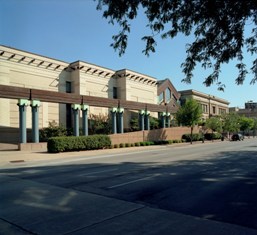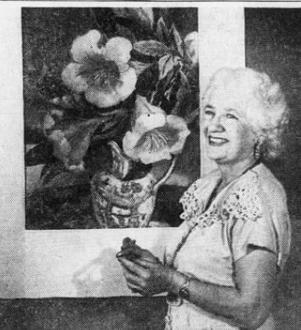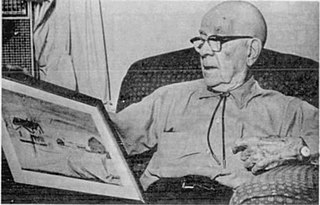
Emanuel Gottlieb Leutze was a German-born American history painter best known for his 1851 painting Washington Crossing the Delaware. He is associated with the Düsseldorf school of painting.

Grant DeVolson Wood was an American painter and representative of Regionalism, best known for his paintings depicting the rural American Midwest. He is particularly well known for American Gothic (1930), which has become an iconic example of early 20th-century American art.

Gilbert Stuart was an American painter from Rhode Island Colony who is widely considered one of America's foremost portraitists. His best-known work is an unfinished portrait of George Washington, begun in 1796, which is usually referred to as the Athenaeum Portrait. Stuart retained the original and used it to paint scores of copies that were commissioned by patrons in America and abroad. The image of George Washington featured in the painting has appeared on the United States one-dollar bill for more than a century and on various postage stamps of the 19th century and early 20th century.

American Gothic is a 1930 painting by Grant Wood in the collection of the Art Institute of Chicago.
Ralph Earl was an American painter known for his portraits, of which at least 183 can be documented. He also painted six landscapes, including a panorama display of Niagara Falls.

The Stone City Art Colony was an art colony founded by Edward Rowan, Adrian Dornbush, and Grant Wood. The colony gathered on the John A. Green Estate in Stone City, Iowa during the summers of 1932 and 1933.
Washington High School is a public high school in Cedar Rapids, in the U.S. state of Iowa. Built in 1956, it is named in honor of the oldest high school in Cedar Rapids.

Marvin Dorwart Cone was an American painter in the regionalist style.

Shirley Jaffe was an American abstract painter. Her early work is of the gestural abstract expressionist style, however in the late 1960s she changed to a more geometric style. This change was initially received with caution by the art world, but later in her career she was praised for the "idiosyncratic" and individual nature of her work. She spent most of her life living and working in France.

The American Gothic House, also known as the Dibble House, is a house in Eldon, Iowa, designed in the Carpenter Gothic style with a distinctive upper window. It was the backdrop of the 1930 painting American Gothic by Grant Wood, generally considered Wood's most famous work and among the most recognized paintings in twentieth century American art. Wood, who observed the house only twice in his lifetime, made only an initial sketch of the house—he completed American Gothic at his studio in Cedar Rapids.

Nan Wood Graham was an American artist and art teacher. She was the sister of painter Grant Wood. She is best known as the model for the woman in her brother's most famous painting, American Gothic (1930).

The Cedar Rapids Museum of Art is a museum in downtown Cedar Rapids, Iowa, United States. The museum is privately owned and was established in 1905. The museum acquired the old Cedar Rapids Public Library building after the library moved into a new location in 1985. The current home of the museum, designed by post-modern architect Charles Moore, was built adjoining the old library in 1989.

The Veteran's Memorial Building is located on May's Island in the middle of the Cedar River in Cedar Rapids, Iowa, United States. It is a contributing property to the May's Island Historic District that was listed on the National Register of Historic Places in 1978. The building served as the Cedar Rapids City Hall until it was damaged in the Flood of 2008. The Building underwent a ribbon-cutting ceremony to mark its official re-opening April 15, 2014.

Love's Messenger is an 1885 watercolor by Marie Spartali Stillman in which a dove has just carried a love letter to a woman standing in front of an open window. She wears a red rose, and has just put down her embroidery of a blind-folded Cupid.

Mildred W. Pelzer was an American art teacher, artist and muralist known for her work in public spaces. In addition to the mural for the post office mural project in Waverly, Iowa, she completed eight murals for the Hotel Jefferson, of Iowa City and a mural for the lobby of the Press-Citizen. In addition to her mural work, Pelzer was known for portraits, floral works and landscapes.

The George B. Douglas House, which later became known as Turner Mortuary East, is owned today by The History Center, Linn County Historical Society. This historic building located in Cedar Rapids, Iowa, United States. The house was built for Douglas who was a partner in a cereal mill that became the Quaker Oats Company. David Turner bought the property in 1924 and converted the house into a funeral home. He was a patron of regionalist artist Grant Wood, and Turner leased the carriage house to him from 1924 to 1933. Wood used it as his residence, along with his mother, and as a studio. It was here at #5 Turner Alley that he painted two of his most famous paintings, American Gothic (1930) and Stone City (1930). Wood also worked as a decorator when he lived here and designed the interior of the main house when it was converted into a funeral home. His work included two stained glass windows that flank the main entrance. Several Wood paintings also hung in the funeral home.

Washington Crossing the Delaware is the title of three 1851 oil-on-canvas paintings by the German-American artist Emanuel Leutze.
Deborah Dancy, also known as Deborah Muirhead, is an American painter of large-scale abstractions in oil; she is also a printmaker and mixed media artist. Her work is also known to encompass digital photography. In 1981, she began to teach at the University of Connecticut, Storrs, where she taught painting for thirty-five years until her retirement in 2017. She has received awards such as a John Simon Guggenheim Foundation Fellowship, Women’s Studio Workshop Studio Residency Grant, and a YADDO fellowship.
James Claussen is a contemporary American lithographer and abstract painter. His lithography is distinguished by the technique of drawing directly on the stone surface as a second drawing process. His paintings combine surrealism with abstraction.

Robert Byron Tabor (1882–1972) was an American painter. He began his painting career when he was 51 years old. His artwork has been featured in the Museum of Modern Art, the Joslyn Art Museum, the White House, and other places. Tabor's first major artwork was Vendue in 1934 and his last major one was Discovery in 1962.
















